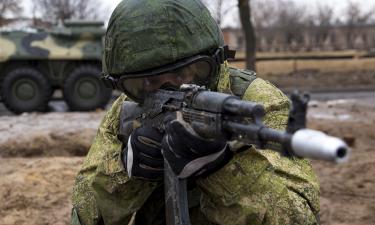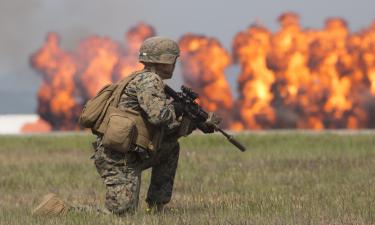"Gorshkov" Ready For Signature
Delhi and Moscow overcame all hurdles, belied all dismal prognoses and brushed aside threats of sanctions to wrap up an agreement on the price of Russian aircraft carrier Admiral Gorshkov. Before that there was a bit of drama in the Indian capital with conflicting reports on the negotiations. India’s Navy chief Admiral Madhavendra Singh told newsmen last week that the two sides had reached an agreement on the price of the ship and that the deal was ready for signature. The very next day a Press Trust of India report from Moscow quoted Russian Defense Ministry denying such an understanding. But the Indian Defense Ministry lost no time in asserting that there was no controversy over buying the Russian aircraft carrier. India’s Minister of State for Defense Rajgopal confirmed that the deal would be signed when Russia’s Minister for Defense Sergei Ivanov visits Delhi at the end of this month.
The biggest-ever defense deal between the two countries, the aircraft carrier, combined with the recently-tested Brahmos missile, will triple India’s nuclear deterrent beside making China and Pakistan sit up and take notice. After the two sides sign the contract, the carrier will take 52 months to be refurbished and fitted with new electronic equipment. Gorshkov is a power projection carrier capable of delivering hits at even shore-based enemy air forces. It provides India a weapons platform far superior and capable than others in the entire region. Gorshkov will come with a 10,800 sq.meter flight deck, new generators, boilers, weapons systems, anti-submarine Komanov helicopters and a 14-degree bow ski jump for a very potent fourth generation, multi-role MIG 29Ks.
India’s Navy chief regards the acquisition of the carrier as a ‘very, very fine deal’ and one that would put India into a different league because of its power projection capability to take on even shore-based air forces. The fleet will totally alter the strategic scene in the subcontinent. It will cost less than Rs. 3,000 crores ( US $650 million) to refit the carrier though what the squadron of fourth generation MIG 29 Ks will cost the Indian treasury is still not known. Defense experts estimate that the aircraft may cost $ 1.5 billion. Two more squadrons will follow, one to be shore-based and another on an air defense warship that will escort Gorshkov. This man of war is under construction indigenously and is expected to be ready by 2010.
India badly needs the Russian aircraft carrier because it now has only one carrier INS Viraat with an operational life of four more years. Therefore, India has plans to create a three-carrier force for the aviation wing of the Indian Navy. The plans include the leasing of two nuclear-powered Russian submarines. Before the talks on Gorshkov’s price came to an end, four Indian Navy teams visited Moscow and endorsed the acquisition because the carrier is capable of remaining operational for 20 years after it is refitted and commissioned. An all-party standing committee of India’s parliament suggested that the Defense Ministry reduce its over-dependence on Russia for military equipment and float global tenders to ensure competitive prices. But the military told the committee that Russia had proved itself a dependable ally in times of need, like the war with Pakistan in the summer of 1999 and when western countries imposed sanctions on India after it carried out a nuclear test in 1998.
Some experts thought that as a conventional air platform Gorshkov was not of much use to the Indian Navy because it does not provide India with an additional nuclear weapons deployment platform. And because it can field only short-range MIG 29K combat aircraft, it does not pose any threat to any country other than Pakistan. Its only use is as a training platform and as a standby till the indigenous carrier fleet is introduced. However, the Indian Navy does not agree with these perceptions. These differences of views were not the reason for the delay in coming to an agreement on the price of the aircraft carrier. It was due to the time taken to work out modalities for ensuring steady supply of spares and to agree on the price of the fighter aircraft and helicopters for the carrier.
The Indian Navy recently commissioned INS Talwar, INS Trishul and two Russian frigates. The Navy chief, however, parried questions on India’s plans regarding TU22M3 long-range strategic bombers and Akula class nuclear submarines which are part of the Gorshkov package. TU22M3 is a long-range bomber which will be the first of its kind in the Indian arsenal. It is also comparatively immune to first strike and even, according to experts, later counterstrikes and can operate from bases deep within Indian Territory. The Akula class submarines are considered the best buy. Two of them can effectively block the port of Karachi in less than a day.
At present, Moscow has agreed to freeze the price of the MIGs for at least five years when they would be inducted. Negotiations are continuing for the prices of other systems such as missiles. According to Defense Ministry sources, the Navy is evaluating the missiles systems for close protection for the carrier from enemy aircraft. For the supply of missiles systems, Israel and France are also contenders. Now all speculation about Admiral Gorshkov should stop. The two sides are continuing talks on the acquisition of the systems to equip the carrier. The emphasis now is on quality because there are other rivals competing for the contract and because there is the parliament to which the Defense Ministry is accountable.
Dasu Krishnamoorty
Special to Pravda.Ru
Subscribe to Pravda.Ru Telegram channel, Facebook, RSS!




